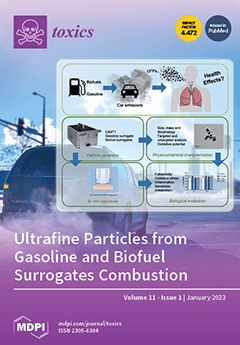The effective management and regulation of fine particulate matter (PM
2.5) is essential in the Republic of Korea, where PM
2.5 concentrations are very high. To do this, however, it is necessary to identify sources of PM
2.5 pollution and determine the
[...] Read more.
The effective management and regulation of fine particulate matter (PM
2.5) is essential in the Republic of Korea, where PM
2.5 concentrations are very high. To do this, however, it is necessary to identify sources of PM
2.5 pollution and determine the contribution of each source using an acceptance model that includes variability in the chemical composition and physicochemical properties of PM
2.5, which change according to its spatiotemporal characteristics. In this study, PM
2.5 was measured using PMS-104 instruments at two monitoring stations in Bucheon City, Gyeonggi Province, from 22 April to 3 July 2020; the PM
2.5 chemical composition was also analyzed. Sources of PM
2.5 pollution were then identified and the quantitative contribution of each source to the pollutant mix was estimated using a positive matrix factorization (PMF) model. From the PMF analysis, secondary aerosols, coal-fired boilers, metal-processing facilities, motor vehicle exhaust, oil combustion residues, and soil-derived pollutants had average contribution rates of 5.73 μg/m
3, 3.11 μg/m
3, 2.14 μg/m
3, 1.94 μg/m
3, 1.87 μg/m
3, and 1.47 μg/m
3, respectively. The coefficient of determination (R
2) was 0.87, indicating the reliability of the PMF model. Conditional probability function plots showed that most of the air pollutants came from areas where PM
2.5-emitting facilities are concentrated and highways are present. Pollution sources with high contribution rates should be actively regulated and their management prioritized. Additionally, because automobiles are the leading source of artificially-derived PM
2.5, their effective control and management is necessary.
Full article






